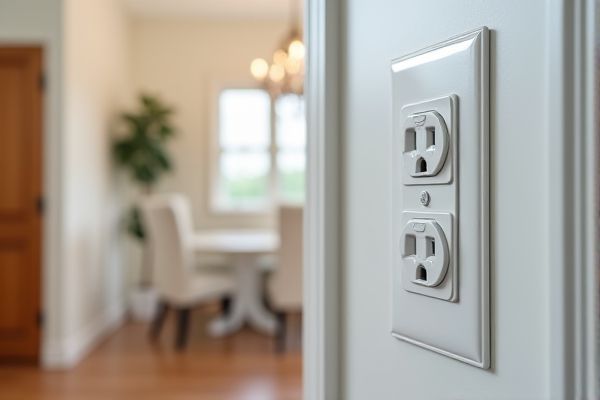
A GFCI outlet provides enhanced safety by quickly cutting off power during ground faults, significantly reducing the risk of electric shock compared to a standard outlet. Discover how choosing the right outlet can protect your home and ensure your family's safety by reading the full article.
Table of Comparison
| Feature | GFCI Outlet | Standard Outlet |
|---|---|---|
| Safety | Protects against electrical shock by shutting off power during ground faults | No ground fault protection |
| Installation Location | Required in wet or damp areas: kitchens, bathrooms, outdoors | Used in dry, general-purpose indoor locations |
| Cost | Higher initial cost ($20-$50 per outlet) | Lower initial cost ($1-$5 per outlet) |
| Reset Button | Includes test and reset buttons for safety testing and restoration | No test or reset buttons |
| Code Requirements | Required by NEC in specific locations | No mandatory code requirements |
| Functionality | Monitors current flow to prevent electrical shock | Delivers power without monitoring |
| Typical Lifespan | 5-10 years, may require replacement for safety | 10+ years, mainly depends on wear and tear |
Understanding GFCI Outlets
GFCI outlets protect against electrical shock by detecting ground faults and quickly shutting off power, unlike standard outlets that lack this safety feature. Commonly installed in moisture-prone areas such as kitchens, bathrooms, and outdoor spaces, GFCI outlets help prevent electrical injuries and fires. Ensuring your home has GFCI outlets in these key locations enhances safety for your family and properties.
What Is a Standard Outlet?
A standard outlet, also known as a duplex receptacle, provides a basic electrical connection for two devices and lacks built-in safety features. It supplies 120 volts of power typically used for everyday household appliances and electronics. Unlike GFCI outlets, standard outlets do not detect ground faults or protect against electrical shock hazards.
Key Differences Between GFCI and Standard Outlets
GFCI outlets protect against electrical shock by detecting ground faults and cutting off power within milliseconds, unlike standard outlets that lack this safety feature. Standard outlets provide basic power supply without monitoring current flow, making GFCIs essential in wet or damp environments like kitchens and bathrooms. You should install GFCI outlets where electrical safety is critical to prevent electrical hazards and enhance protection.
How GFCI Outlets Enhance Electrical Safety
GFCI outlets enhance electrical safety by quickly detecting ground faults and cutting off power within milliseconds, reducing the risk of electric shock. These outlets monitor electrical current flow and automatically trip when they sense imbalances, preventing potential electrocution in wet or damp environments like kitchens and bathrooms. Standard outlets lack this protective mechanism and can pose a higher hazard in areas prone to moisture exposure.
Installation Locations: Where GFCI Outlets Are Required
GFCI outlets are required in areas with high moisture levels such as bathrooms, kitchens, garages, basements, and outdoor locations to prevent electrical shock. Standard outlets are typically installed in dry, general living spaces like bedrooms and living rooms where moisture exposure is minimal. Building codes, including the National Electrical Code (NEC), mandate GFCI installation in these wet or damp environments to enhance safety compliance.
Cost Comparison: GFCI vs. Standard Outlets
GFCI outlets typically cost between $15 and $30 each, significantly higher than standard outlets, which usually range from $1 to $5. The installation of GFCI outlets may incur additional labor costs due to their wiring complexity and code requirements, especially in wet or outdoor locations. Despite the higher upfront expense, GFCI outlets enhance safety by protecting against electrical shock, potentially saving costs related to injury or damage.
Electrical Code Requirements for Outlets
The National Electrical Code (NEC) mandates GFCI (Ground Fault Circuit Interrupter) outlets in locations with increased risk of electrical shock, such as bathrooms, kitchens, garages, and outdoor areas, whereas standard outlets are typically acceptable in dry, interior spaces. GFCI outlets provide enhanced safety by quickly cutting off power during ground faults, meeting strict code requirements for residential and commercial buildings. Understanding these regulations ensures your electrical system complies with legal standards and protects your property and loved ones.
Pros and Cons of GFCI Outlets
GFCI outlets provide enhanced safety by quickly cutting off power during ground faults, significantly reducing the risk of electric shock, especially in wet areas like kitchens and bathrooms. They offer protection beyond standard outlets but tend to be more expensive and may cause nuisance tripping under certain conditions. While standard outlets are cost-effective and widely used, they lack the advanced safety features that GFCI outlets deliver.
Common Problems and Troubleshooting
GFCI outlets commonly trip due to ground faults or moisture intrusion, which can be identified by a reset button that fails to stay engaged. Standard outlets may experience loose wiring or worn contacts, causing intermittent power loss or sparking. You can troubleshoot GFCI issues by testing the reset button and inspecting for water damage, while standard outlets require checking for secure connections and replacing faulty components.
Choosing the Right Outlet for Your Needs
Choosing the right outlet depends on safety requirements and location-specific electrical codes, with GFCI outlets offering enhanced protection against electrical shocks in wet or damp areas such as kitchens, bathrooms, and outdoor spaces. Standard outlets are typically sufficient for dry, low-risk environments but lack the ground-fault detection features found in GFCI receptacles. Understanding the function and placement of each outlet type ensures compliance with NEC (National Electrical Code) standards and optimal safety.
 homyna.com
homyna.com